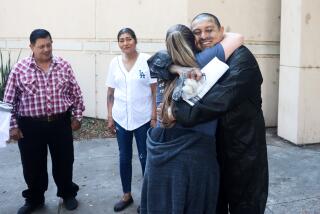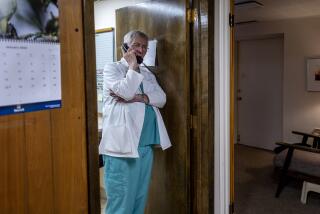COLUMN ONE : When a Mother Kills
The fate of two little boys in South Carolina has forced Americans to confront painful questions about why a woman would take her own children’s lives.
“I just hope they were asleep or something and didn’t know the horror of dying alone in that car. I’m just stunned and disappointed in the mother. Evidently they were in the way of what she wanted to do with her life.”
--Alice Valentine neighbor of Susan Smith
For many, the idea is nearly impossible to comprehend.
The deaths of Susan Smith’s two young sons in Union, S.C., and recent cases in San Jacinto, Calif., and Florida, have forced Americans to consider the possibility that a woman might kill her child--then go on national TV to gain public sympathy by blaming someone else.
After nine days of listening to Smith’s story that a carjacker had abducted her sons, Michael, 3, and Alexander, 14 months, the nation was shocked to learn Thursday that the 23-year-old mother had confessed to strapping the boys into car seats and driving her Mazda into a lake.
Only a week earlier, Dora Buenrostro of San Jacinto was arrested on suspicion of stabbing to death her three children, ages 9, 8 and 4, after failing to convince police that her estranged husband had killed them.
And in Florida, Pauline Zile was charged Friday with murder in the death of her 7-year-old daughter, whom Zile had earlier claimed had been abducted from a Ft. Lauderdale restroom. After a six-day nationwide search, police said, Zile confessed that her husband had beaten his stepdaughter to death. Walter John Zile has been charged with murder.
*
An estimated 650 to 700 mothers kill their children each year, according to Richard J. Gelles, director of the Family Violence Research Project at the University of Rhode Island.
That represents more than half of the 1,300 children killed by parents or caretakers each year since 1976, he said.
Gelles suggests that mothers are slightly more likely than fathers to be involved in such cases because they have a greater responsibility for child care and endure a disproportionate amount of stress.
Indeed studies have found that stress can play a large role in exacerbating the situations that often lead mothers to kill:
They suffer from severe mental illness;
They decide they no longer want their child;
They accidentally batter a child to death;
They want to seek revenge against a spouse;
And, strangely, they sometimes feel a misguided sense of altruism. These mothers either feel they are protecting a child from suffering, or identify with the child in a confused suicide attempt.
“The group we have the easiest time (understanding) have postpartum depression,” said Mark J. Mills, a UCLA forensic psychologist. “They are really psychotic.”
Over the last two decades, about three dozen deaths have been attributed to the illness, which surfaces without warning with delusions, hallucinations and personality changes.
Other women suffer from illnesses including schizophrenia or bipolar depression. Pregnant women with these conditions may forgo their treatment because drugs such as lithium may put the fetus at risk, experts said.
Some mothers may be healthy but appear to snap under the stress of raising a child without adequate support from family or friends.
“Child rearing is about as demanding a task (as) there is,” Mills said. It “is enormously taxing and challenging. You never have any private time or space. You’re always beleaguered, often tired. It’s a wonder more kids are not battered, beaten, drowned or killed.”
Mothers under extreme stress often give clues--telling others that they feel they will harm their children.
“In the old days, the visiting nurse used to come out and visit every new mom,” said Elissa Benedek, a forensic psychiatrist at the University of Michigan Medical Center. “She was very sensitive about picking up clues.”
But today, without such support systems, some mothers begin to feel incompetent, she said. They feel hopeless, as if they were painted into a corner. This may exacerbate other problems, including illness or feelings of isolation.
“Many say ‘I am overwhelmed. I can’t take care of this child. I want to protect the child.’ Sometimes they kill them in order to protect them,” Benedek said.
“They have tried to communicate to people how frightened and desperate they are,” she said. “How scared, how worried, how overwhelmed and people don’t listen. It is not a message that anybody wants to hear.”
She said medical students are taught to pay attention “if there’s a new mom, or any mom, who says she’s worried she’s going to harm her children.”
Sue Myer, director of the Los Angeles-based Childhelp/IOF Child Abuse Hotline, said that counselors often help mothers on the edge. She said it’s not uncommon to get calls saying, “If you don’t help me stop this child from screaming, I’ll kill him. . . . The sad part is that (a mother) could have called the hot line to get counseling or talk about their feelings.”
*
In concocting elaborate tales to cover their crimes, some mothers are relying on society’s deep resistance to believing they could be responsible.
Elizabeth Diane Downs was convicted of killing her 7-year-old daughter and wounding her two other children on a rural road outside Springfield, Ore., in 1983. Downs had claimed that “a bushy-haired stranger” waved down her car on a deserted road and shot her children. Prosecutors alleged Downs shot her children because they were spoiling her relationship with a boyfriend who did not want to be a father.
Last year, Philadelphia mother Vivian King, 42, reported her 17-year-old daughter Shilie Turner missing. The community rallied around her, raging about the violence in the neighborhood. More than a month later, her bullet-ridden body was found in a park and King confessed to shooting her during what police said was an argument.
In a widely publicized case in 1987, Sheryl Lynn Massip of Anaheim at first claimed that her baby had been kidnaped. But she later recanted and was found guilty of murder. The verdict was overturned by a judge who decreed Massip suffered from postpartum psychosis.
Some suggest the tales are so implausible that the mothers are harboring an unconscious desire to be caught and punished.
Others point to specific personality traits.
In premeditated cases such as Downs’, there are three elements, said Ann Rule, who wrote a book about the case. “First, an antisocial personality. Second, histrionics. The actress taking over. Third, you have narcissism. ‘I deserve whatever I want because I’m special.’ Whatever they have to do to get what they want, they will do. And whoever gets hurt, that isn’t really bad because they’re so special.”
One profile of a child killer is a sociopathic personality who has a reduced capacity to feel guilt and does not bond with others, including children.
Charles Ewing, professor at State University of New York-Buffalo, author of the upcoming book, “Fatal Families,” suggested that it is the idea of deception that has triggered such outrage in the Smith case.
Some mothers can keep up an elaborate manipulation because they come to believe what they are saying. “In many of the cases, the natural response to the overwhelming guilt that you feel is denial. And that denial is immediately reinforced. You get this outpouring of sympathy and support. . . . In the long run, though, once it becomes apparent that she has deceived then the table turns and you go from being this very sympathetic mother to being the most vile of killers.
“There is a sense that we are going to punish you not only for killing your kids, but for what you did afterward, for taking us all for a ride.”
Some suspect the current cases may only feed a growing national cynicism about parents who claim children have been abducted. But according to Ewing: “It may disabuse us of our naive notion that people don’t hurt the people they love. Not only do they hurt the people they love, they also kill them.
“Maybe that is cynicism, but it is also reality.”
More to Read
Sign up for Essential California
The most important California stories and recommendations in your inbox every morning.
You may occasionally receive promotional content from the Los Angeles Times.










